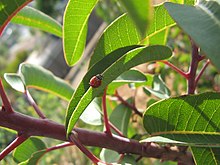Lentisco
| Malosma | |
|---|---|
 |
|
|
Malosma laurina, the Laurel sumac |
|
| Scientific classification | |
| Kingdom: | Plantae |
| (unranked): | Angiosperms |
| (unranked): | Eudicots |
| (unranked): | Rosids |
| Order: | Sapindales |
| Family: | Anacardiaceae |
| Genus: |
Malosma Nutt. ex Abrams |
| Species | |
|
Malosma laurina (Nutt.) Nutt. ex Abrams |
|
Malosma laurina (Nutt.) Nutt. ex Abrams
Malosma is a plant genus which contains only a single species, Malosma laurina, with the common names laurel sumac and lentisco (Spanish).Malosma laurina is found along the Southern California and Baja California Peninsula coasts of the Pacific Ocean.
Malosma laurina is a large, rounded evergreen shrub or small tree growing 3 to 5 meters (10–15 feet) tall.
The leaves have a taco shell shape. When flattened, they have the shape of laurel leaves, with lance-shaped leaf blades up to 10 cm (4") long. The tips of the stems, little stem attaching the leaf to the stems (petiole), the veins of the leaves, and the edges of the leaves, are a glowing reddish color all year long.
The fragrant leaves and stems give chaparral its characteristic fragrance. The leaves and stems are full of volatile compounds that give it the scent. Laurel sumac has adapted to fire return intervals of 50-100+ years in the chaparral areas where it grows, and after a fire burns its above ground parts, a large burl underground resprouts new stems and leaves.
In southern California where it grows, the winters are relatively wet and the summers are dry (a Mediterranean climate). The laurel sumac grows new leaves and stems all year long, even during dry season. Most other plants where it grows stop growing leaves during the summer dry season and focus their energies on their root systems. The fragrant saps flow through laurel sumac all year to supply the leaves. One effect of this is that laurel sumac is one of the first plants that resprout after a fire, before the winter rains cause other plants to stop being dormant for the dry season. Another effect is that the parasitic plant (a plant that grows into other plants, not the soil) California dodder (Cuscuta californica), which dies in the summer on other plants, can be seen covering laurel sumac in large stringy "cobwebs" of yellow/orange color.
Laurel sumac is sensitive to cold and does not tolerate freezing conditions. Orange growers in the early history of southern California used to pick places to plant their oranges based on where laurel sumac was growing because this indicated it would not get too cold for oranges if laurel sumac could grow there.
...
Wikipedia
